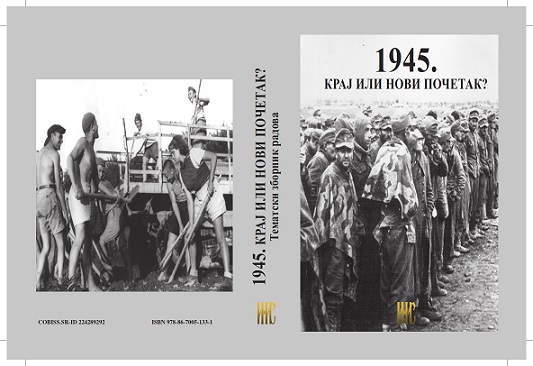Uklanjanje 1945/46. grobalja i grobova "okupatora" i "narodnih neprijatelja" poginulih 1941-45. na području Nezavisne Države Hrvatske
Removal of the Graves and Graveyards of "Occupiers" and "Enemies of the People" who had Died in the Territory of the Independent State of Croatia 1941-1945
Author(s): Vladimir Geiger
Subject(s): Civil Society, Military history, Political history, Government/Political systems, WW II and following years (1940 - 1949), History of Communism, Fascism, Nazism and WW II, Politics of History/Memory
Published by: Institut za noviju istoriju Srbije
Keywords: 1945; Croatia; Bosnia and Herzegovina; Eastern Syrmia; Ministry of Interior Affairs of Democratic Federated Yugoslavia; communist repression; monuments; graves; memoricide;
Summary/Abstract: The duration and intensity of WWII in the territoiy of the Independent State of Croatia, the presence of occupation forces of the German Reich and the Kingdom of Italy, armed forces of the Independent State of Croatia, as well as the activities of the Yugoslav monarchists and communist-led partisans, caused direct clashes between the belligerent parties. This led to a number of casualties both among soldiers and civilians. Irreconcilable ideologies and military and political interests of the conflicting parties in the general and civil war increased the number of casualties. The communists reckoning with real or purported enemies alike in Yugoslavia during WWII and especially at its end and right after it, was massive and without mercy. Part of the radical and total reckoning of the Yugoslav communists with their enemies immediately after WWII was the order of the Interior Ministry of the Democratic Federal Yugoslavia of May 18, 1945 about removal of graves of "occupiers" and "enemies of the people" that targeted graves, tombstones of German, Italian and Hungarian armies, as well as those of the ustasha, chetniks and Slovenian home guards. The fact that the order was systematically implemented in the territory of the Independent State of Croatia is proven by surviving documents and testimonies of eyewitnesses, as well as by the state of the graveyards themselves. The graves of fallen partisans and victims of "Fascist terror" were protected by law, put in order and well maintained in Yugoslavia after WWII, whereas the graves of "enemy" soldiers and "collaborators" remained outside of the pale of the law. This remained so until the break-up of Yugoslavia.
Book: 1945. Kpaj или нови почетак?
- Page Range: 185-226
- Page Count: 42
- Publication Year: 2016
- Language: Croatian
- Content File-PDF

